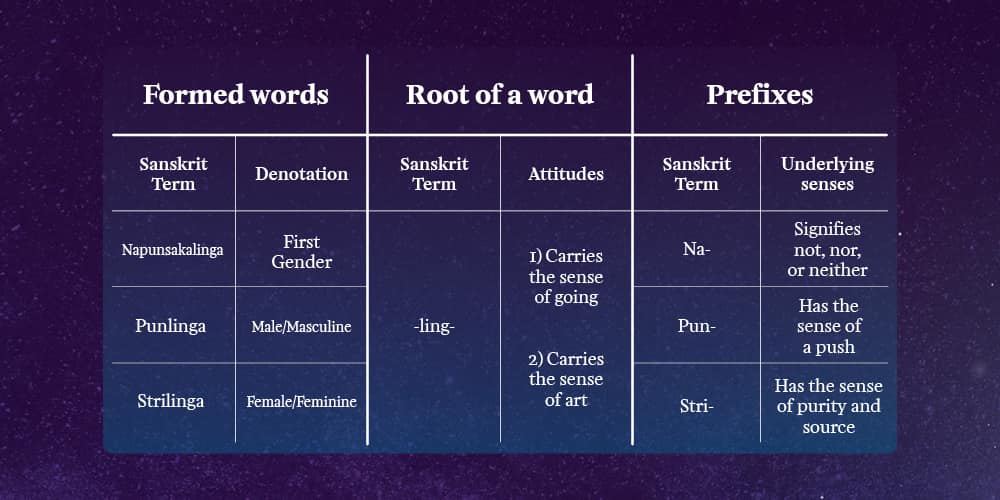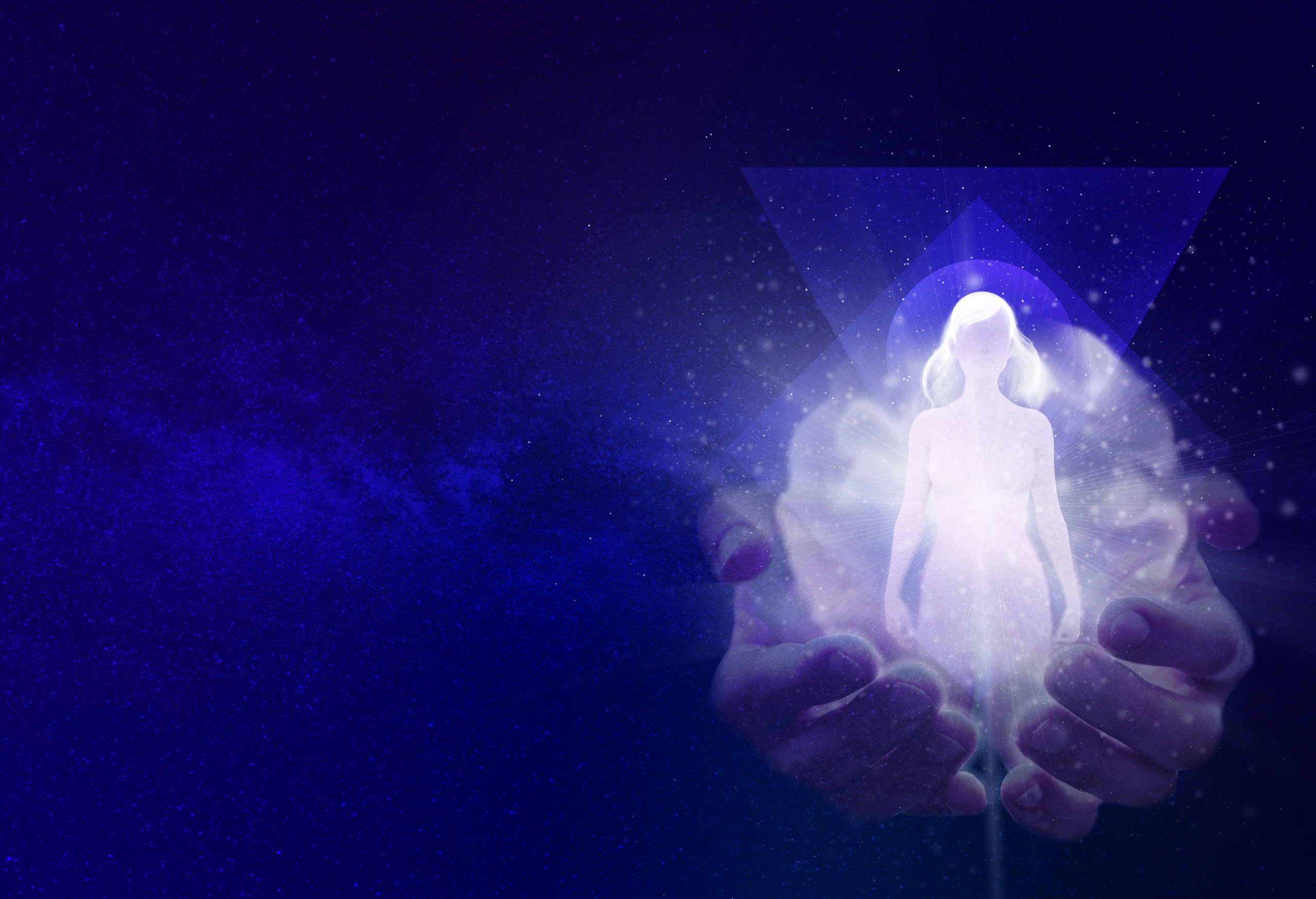Western tradition tends to view gender as something binary, either male or female. Fran Borg’s research takes a closer look at how Sanskrit philosophy understands the inseparability of gender through language and mythology.
The act of creation incorporates the notion of destruction, and encapsulated within creation and destruction is the idea of maintenance. This is symbolised and understood in Hindu religion and philosophy within the Trimurti: Brahma as Creator, Vishnu as Preserver, and Shiva as Destroyer.
While the masculine trinity is well-known in the West, the feminine aspect is often overlooked. In Sanskrit, the concepts of male and female are inseparable from one another. This is not only reflected in the mythology, but it is also embedded within the language of Sanskrit itself. One researcher, Fran Borg, grapples with the Sanskrit language and mythology and reveals a surprisingly modern interpretation of gender.
The Trinity: the Trimurti and the Tridevi
The trinity, Brahma, Vishnu and Shiva, are manifested from the Absolute, referred to as Brahman. It is through Brahman that the manifestation of the Universe takes place and that the cycle of creation, maintenance, and destruction can unfold. Rather than viewing Brahma, Vishnu, and Shiva as three separate entities, it is important to note the relationship between them. Creation cannot occur without destruction, and destruction without preservation.
Borg argues that to fully appreciate this trinity, one must also understand their feminine parallel. In fact, for Borg, this is the starting point to understanding how gender is conceptualised in Sanskrit.
The female counterpart, known as the Tridevi (the three goddesses), are the consorts of Brahma, Vishnu, and Shiva. The Tridevi consists of Saraswati, Lakshmi, and Paravati, and each holds a union with the Trimurti.
Saraswati and Brahma
Brahma is seen as the creator, and his consort, Saraswati, aided in giving order to creation. She is the goddess of wisdom, the arts, and ‘stream of speech.’ She is often depicted as sitting on a white lotus. In mythology, Brahma and Saraswati are acknowledged as having created the Sanskrit symbols. This is one of the ways in which the Sanskrit language is understood as divine or transcendental. The Sanskrit script is named the ‘Devanagari’ script; deva is translated as ‘god’, and nagari is translated as ‘valley’. Indeed, Sanskrit was considered the language of the gods. It is said that Saraswati held the divine word while Brahma manifested it into reality — creating the Sanskrit symbols.
Lakshmi and Vishnu
Lakshmi is Vishnu’s consort. Just as Vishnu is seen as the ‘Preserver,’ Lakshmi also maintains balance through fortune and misfortune. She symbolises beauty, happiness, and surplus and has been compared with the Greek goddess Aphrodite. She is often depicted as holding lotus blossoms. In myth, Lakshmi and Vishnu are inseparable and are born together in their various forms; when Vishnu was born Parashu-Rama, Lakshmi was Dharani. When he was incarnated as Raama, she was Sita.
Parvati and Shiva
Shiva is seen as the god of destruction and as granting limits to reality to give shape and form to the Universe. His consort, Paravati, brings limits to Shiva’s destruction, balancing his unbridled passions. She is also depicted as having a playful character as seen in one myth where she covers Shiva’s eyes. At that moment a third eye appeared on Shiva’s forehead so that the Universe would not be enveloped in darkness. Paravati is closely identified with prakriti, known as natural or primal matter. She is also known as ‘world mother’ or ‘divine mother’ and is connected to the notion of shakti.
Shakti is understood as feminine energy and is contrasted with masculine energy, passive energy, or even the limited energy of humankind. In the Atharvaveda (a vedic scripture of Hinduism), there are references of power or natural power being associated with pure female energy. Borg points out how shakti became associated with Shaivism and each goddess was considered to be a shakti. Linked to shakti is the symbol of yoni which is depicted as the female genital organ, a triangle with its apex pointing downwards. It is the source of all things and is understood as the origin of all life.
Gender in Sanskrit: Linga
Just as the Tridevi and Trimurti are seen as complementary, this is also reflected within the Sanskrit language. Borg’s research takes a closer look at Sanskrit translations and grammar to better understand the relationship between genders.
‘Force without forcefulness would not be made manifest, while forcefulness without force, on the other hand, would have no means to action, remaining motionless.’
The term linga can be roughly translated to ‘gender’. Linga, however, is far more nuanced. In Sanskrit, the terms for male and female (punlinga and strilinga respectively) each comes from the same root, ling. This already highlights the inseparability between the two terms. However, this is taken a step further when we understand that pun has the sense of ‘push’ or ‘force’ while stri has the sense of purity and source. In this way, the masculine is seen as the forcefulness and the feminine as seen as the ‘force’. As Borg succinctly puts it: ‘Force without forcefulness would not be made manifest, while forcefulness without force, on the other hand, would have no means to action, remaining motionless.’

To explain this, Borg points towards the relationship between the seed and the stem. ‘The seed contains the potential plant within it, representing the force of femininity (strilinga). As the stem pushes out of the seed during growth, this push can be seen as the forcefulness of masculinity (punlinga). Through this forcefulness manifests the force of femininity.’
Much like the seed and the stem, the force and the forceful cannot be set apart from one another, nor should the one be understood in isolation from the other.
Borg is quick to point out that this does not imply that genders are the same, or that men and women do not take on different social or gender roles, but that the concepts of masculinity and femininity are inseparable from one another. When conceiving of the masculine or feminine, we cannot talk about one without remembering the other. In mythology, this is reflected in the gods and goddesses. Indeed, when one is invoked the other is necessarily remembered.
Transcendence of Gender
In some languages, there is also the ‘neuter gender’ (such as ‘it’ in English or ‘das’ in German). Similarly, in Sanskrit, na may be used to refer to inanimate objects. However, the first gender also represents the transcendence of gender. The transcendence of gender includes both, in such a way as to contain both whilst being contained by neither.
This can be seen through the formation of the word napunsakalinga, ‘neither-masculine-nor-feminine’.
This is reflected in the Absolute, which supersedes gender. The manifestation of the Universe and the existence of the deities can only exist and become reality through the Absolute.
In the West, we tend to take a binary view on gender, either male or female, though gender goes beyond the constructions of male and female. However, the structure of Sanskrit as well as the mythology behind it suggests a surprisingly modern view of gender. Rather than viewing male and female as two distinct forms, Sanskrit and the relationship between Trimurti and Tridevi frames them as inseparable and interdependent. Is this non-dual approach to gender the key to dismantling our preconceptions of gender in our society?
References
Borg, F. (2015). Linga: A Philosophical Inquiry of Gender in Sanskrit. University of Malta.
Fischer-Schreiber, I., Schuhmacher, S., Kohn, M. and Lubin, T. (1989). The encyclopedia of Eastern philosophy and religion. Boston, MA: Shambhala.
Hodgkinson, B. (2006). The essence of Vedanta. London: Arcturus.
Monier-Williams, M., Cappeller, C. and Leumann, E. (2006). Sanskrit English dictionary. New Delhi: Manohar.
Stutley, M. and Stutley, J. (1984). Harper’s dictionary of Hinduism. San Francisco: Harper & Row.





Comments are closed for this article!